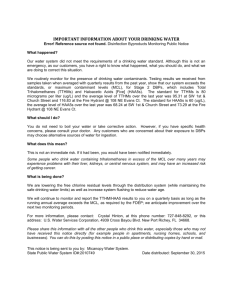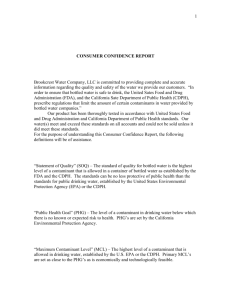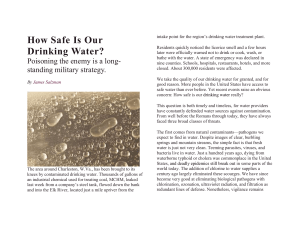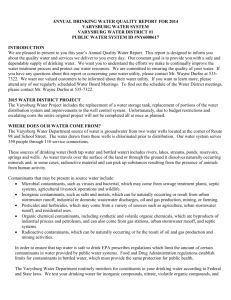The Town of Tusten Water Report for 2007
advertisement
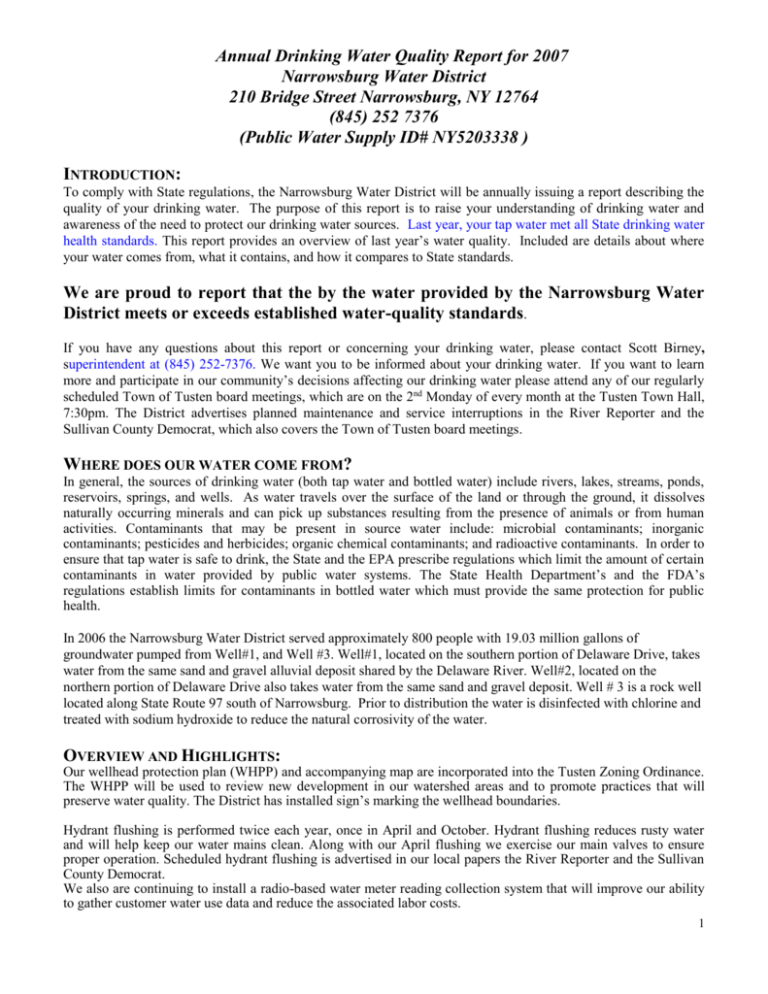
Annual Drinking Water Quality Report for 2007 Narrowsburg Water District 210 Bridge Street Narrowsburg, NY 12764 (845) 252 7376 (Public Water Supply ID# NY5203338 ) INTRODUCTION: To comply with State regulations, the Narrowsburg Water District will be annually issuing a report describing the quality of your drinking water. The purpose of this report is to raise your understanding of drinking water and awareness of the need to protect our drinking water sources. Last year, your tap water met all State drinking water health standards. This report provides an overview of last year’s water quality. Included are details about where your water comes from, what it contains, and how it compares to State standards. We are proud to report that the by the water provided by the Narrowsburg Water District meets or exceeds established water-quality standards. If you have any questions about this report or concerning your drinking water, please contact Scott Birney, superintendent at (845) 252-7376. We want you to be informed about your drinking water. If you want to learn more and participate in our community’s decisions affecting our drinking water please attend any of our regularly scheduled Town of Tusten board meetings, which are on the 2nd Monday of every month at the Tusten Town Hall, 7:30pm. The District advertises planned maintenance and service interruptions in the River Reporter and the Sullivan County Democrat, which also covers the Town of Tusten board meetings. WHERE DOES OUR WATER COME FROM? In general, the sources of drinking water (both tap water and bottled water) include rivers, lakes, streams, ponds, reservoirs, springs, and wells. As water travels over the surface of the land or through the ground, it dissolves naturally occurring minerals and can pick up substances resulting from the presence of animals or from human activities. Contaminants that may be present in source water include: microbial contaminants; inorganic contaminants; pesticides and herbicides; organic chemical contaminants; and radioactive contaminants. In order to ensure that tap water is safe to drink, the State and the EPA prescribe regulations which limit the amount of certain contaminants in water provided by public water systems. The State Health Department’s and the FDA’s regulations establish limits for contaminants in bottled water which must provide the same protection for public health. In 2006 the Narrowsburg Water District served approximately 800 people with 19.03 million gallons of groundwater pumped from Well#1, and Well #3. Well#1, located on the southern portion of Delaware Drive, takes water from the same sand and gravel alluvial deposit shared by the Delaware River. Well#2, located on the northern portion of Delaware Drive also takes water from the same sand and gravel deposit. Well # 3 is a rock well located along State Route 97 south of Narrowsburg. Prior to distribution the water is disinfected with chlorine and treated with sodium hydroxide to reduce the natural corrosivity of the water. OVERVIEW AND HIGHLIGHTS: Our wellhead protection plan (WHPP) and accompanying map are incorporated into the Tusten Zoning Ordinance. The WHPP will be used to review new development in our watershed areas and to promote practices that will preserve water quality. The District has installed sign’s marking the wellhead boundaries. Hydrant flushing is performed twice each year, once in April and October. Hydrant flushing reduces rusty water and will help keep our water mains clean. Along with our April flushing we exercise our main valves to ensure proper operation. Scheduled hydrant flushing is advertised in our local papers the River Reporter and the Sullivan County Democrat. We also are continuing to install a radio-based water meter reading collection system that will improve our ability to gather customer water use data and reduce the associated labor costs. 1 SOURCE WATER ASSESSMENT: In 1996 congress amended the Safe Water Act to include a new program that would evaluate the sources of public drinking water. The program is called the Source Water Assessment, the New York State Department of Health is responsible for implementing this program, it was created to identify possible contaminate threats to a drinking water source. The NYSDOH has completed their assessment of the Narrowsburg Water District based on information available. Possible and actual threats to the drinking water source have been evaluated. The state source water assessment includes a susceptibility rating based on the risk posed by each potential source of contamination and how easily contaminates can move through the subsurface to the wells. The susceptibility rating is an estimate of potential for contamination of source water, it does not mean that the drinking water delivered to consumers is or will be contaminated. See section “Are there contaminates in our drinking water?” for a list of the contaminants that have been detected. The purpose of the source water assessments is to provide resource managers with additional information for protecting source waters in the future. As mentioned our drinking water is derived from 3-drilled wells. The source water assessment has rated these wells as having a medium high-to-high susceptibility to enteric bacteria and nitrates. These ratings are due to primarily to the close proximity of permitted discharge facilities (industrial/commercial facilities that discharge wastewater into the environment and are regulated by the state and or federal government) in relation to the wells. In addition the wells draw from an unconfined aquifer of unknown hydraulic conductivity. Please note that this report only details the possibility for contamination. Our water is tested regularly to ensure that the finished water coming into your home meets New York State drinking water standards. County and state departments will use this information to direct future source water protection activities. These may include water quality monitoring, resource management, planning, and education programs. A copy of the full report with a map is available upon request from the District ARE THERE CONTAMINANTS IN OUR DRINKING WATER? As the State regulations require, we routinely test your drinking water for numerous contaminants. These contaminants include: total coliform, inorganic compounds, nitrate, nitrite, lead and copper, volatile organic compounds, and synthetic organic compounds. The table presented below depicts which compounds were detected in your drinking water. The State allows us to test for some contaminants less than once per year because the concentrations of these contaminants do not change frequently. Some of our data, though representative, are more than one year old. It should be noted that all drinking water, including bottled drinking water, may be reasonably expected to contain at least small amounts of some contaminants. The presence of contaminants does not necessarily indicate that water poses a health risk. More information about contaminants and potential health effects can be obtained by calling the EPA’s Safe Drinking Water Hotline (800-426-4791) or the New York State Health Department, Monticello District Office at (845) 794-2045. Table of Detected Contaminants Violation Contaminant Yes/No Radioactive Contaminants: Beta particle and No photon activity from manmade radionuclides Inorganics: Barium No Date of Sample Level Detected Unit Measurement MCLG Regulatory Limit (MCL, TT or AL) Likely Source of Contamination 9/5/01 2.21 pCi/l 0 50 (MCL) Decay of natural deposits and manmade emissions. 4/18/06 RANGE 42- 98 HIGH- 98 RANGE14.0-60.0 HIGH- 60.0 RANGEND-01.2 HIGH- 1.2 ug/l 2000 2000 (MCL) mg/l N/A 250 (MCL) Discharge of drilling wastes; Discharge from metal refineries; Erosion of natural deposits. Naturally occurring or indicative of road salt contamination. ug/l 100 100(MCL) Chloride No 3/20/0612/19/06 Chromium No 4/18/06 Discharge from steel and pulp mills; Erosion of natural deposits. 2 Cyanide No 4/18/06 RANGEND-170 HIGH- 170 RANGEND-220 HIGH- 220 ug/l 200 200 (MCL) Fluoride No 4/18/06 ug/l N/A 2200 (MCL) Nickel (Silver) No 4/18/06 RANGE15 - 37 HIGH- 37 ug/l N/A 100 (MCL) Sodium No 3/20/0612/19/06 mg/l See Note 2 N/A (MCL) Selenium No 4/18/06 ug/l 50 50 (MCL) Sulfate Zinc No No 5/2/02 5/2/02 RANGE8.0-35.0 HIGH- 352 RANGE ND- 1.2 HIGH- 1.2 17.0 10 mg/l ug/l N/A N/A 250 (MCL) 5000 (MCL) Nitrate No RANGE 0.3-2.9 HIGH- 2.9 mg/l 10 10 (MCL) ug/l 0 15 (AL) ug/l 1300 1300 (AL) 9/11/06 Lead Copper No 8/30/05 No 8/30/05 Discharge from steel/metal factories; Discharge from plastic and fertilizer factories. Erosion of natural deposits; Water additive that promotes strong teeth; Discharge from fertilizer and aluminum factories. Naturally occurring, discharge from photographic and radiographic processing; Manufacturing of electronic products; Jewelry making; Plating and soldering. Naturally occurring; Road salt; Water softeners; Animal waste. Discharge from petroleum and metal refineries; Erosion of natural deposits; Discharge from mines. Naturally occurring. Naturally occurring: Mining waste. Runoff from fertilizer use; Leaching from septic tanks, sewage; Erosion of natural deposits Corrosion of household plumbing systems; Erosion of natural deposits 2.03 5803 Corrosion of household plumbing systems; Erosion of natural deposits; leaching from wood preservatives Notes: 1. 2. 3. The State considers 50 pCi/l to be the level of concern for beta particles. Water containing more than 20 mg/l of sodium should not be used for drinking by people on severely restricted sodium diets. Water containing more than 270 mg/l of sodium should not be used for drinking by people on moderately restricted sodium diets. The level presented represents the 90th percentile of the 20 sites tested. A percentile is a value on a scale of 100 that indicates the percent of a distribution that is equal to or below it. The 90 th percentile is equal to or greater than 90% of the copper values or lead values detected at your water system. The action level for lead was exceeded at one of the twenty sites tested. After a retest the sample was found to be below the action level and is presumed to have been a sampling error. Definitions: Maximum Contaminant Level (MCL): The highest level of a contaminant that is allowed in drinking water. MCLs are set as close to the MCLG as possible.. Maximum Contaminant Level Goal (MCLG): The level of a contaminant in drinking water below, which there is no known or expected risk to health. MCLGs allow for a margin of safety. Maximum Residual Disinfectant Level (MRDL): The highest level of a disinfectant allowed in drinking water. There is convincing evidence that addition of a disinfectant is necessary for control of microbial contaminants. Maximum Residual Disinfectant Level Goal (MRDLG): The level of a drinking water disinfectant below, which there is no known or expected risk to health. MRDLGs do not reflect the benefits of the use of disinfectants to control microbial contamination. Action Level (AL): The concentration of a contaminant, which, if exceeded, triggers treatment, or other requirements, which a water system must follow. Non-Detects (ND): Laboratory analysis indicates that the constituent is not present. Milligrams per liter (mg/l): Corresponds to one part of liquid in one million parts of liquid (parts per million - ppm). Micrograms per liter (ug/l): Corresponds to one part of liquid in one billion parts of liquid (parts per billion - ppb). Picocuries per liter (pCi/L): A measure of the radioactivity in water. 90th Percentile Value: The values reported for lead and copper represent the 90 th percentile. A percentile is a value on a scale of 100 that indicates the percent of a distribution that is equal to or below it. The 90 th percentile is equal to or greater than 90% of the lead and copper values detected at your water system. 3 New York State Sanitary Code Compliance - Variances and Exemptions: Under a waiver granted by the New York State Department Health our system is not required to monitor for Asbestos and the Synthetic Organic Contaminants- Dioxin, Endothall, and Diquat. Installation and maintenance records indicate that Transite pipe (which contains Asbestos) was not used in the District. Previous sampling for the Synthetic Organic Contaminants has yielded non-detects and were neither used nor produced in the watershed. WHAT DOES THIS INFORMATION MEAN? We have learned through our testing that some contaminants have been detected; however, these contaminants were detected below the level allowed by the State. These contaminants will continue to be monitored for any changes in concentration. DO I NEED TO TAKE SPECIAL PRECAUTIONS? Although our drinking water met or exceeded state and federal regulations, some people may be more vulnerable to disease causing microorganisms or pathogens in drinking water than the general population. Immune-compromised persons such as persons with cancer undergoing chemotherapy, persons who have undergone organ transplants, people with HIV/AIDS or other immune system disorders, some elderly, and infants can be particularly at risk from infections. These people should seek advice from their health care provider about their drinking water. EPA/CDC guidelines on appropriate means to lessen the risk of infection by Cryptosporidium, Giardia and other microbial pathogens are available from the Safe Drinking Water Hotline (800-426-4791). Infants and young children are typically more vulnerable to lead in drinking water than the general population. It is possible that lead levels at your home may be higher than at other homes in the community as a result of materials used in your home’s plumbing. If you are concerned about elevated lead levels in your home’s water, you may wish to have your water tested and flush your tap 30 seconds to 2 minutes before using tap water. Additional information is available from the Safe Drinking Water Hotline (800-426-4791). WHY SAVE WATER AND HOW TO AVOID WASTING IT? Although our system has an adequate amount of water to meet present and future demands, there are a number of reasons why it is important to conserve water: Saving water saves energy and some of the costs associated with both of these necessities of life; Saving water reduces the cost of energy required to pump water and the need to construct costly new wells, pumping systems and water towers Saving water lessens the strain on the water system during a dry spell or drought, helping to avoid severe water use restrictions so that essential fire fighting needs are met You can play a role in conserving water by becoming conscious of the amount of water your household is using, and by looking for ways to use less whenever you can. It is not hard to conserve water. Conservation tips include: Automatic dishwashers use 15 gallons for every cycle, regardless of how many dishes are loaded. So get a run for your money and load it to capacity. Use clothes washers with full loads only. Turn off the tap when brushing your teeth. Check every faucet in your home for leaks. Just a slow drip can waste 15 to 20 gallons a day. Fix it up and you can save almost 6,000 gallons per year. Check your toilets for leaks by putting a few drops of food coloring in the tank, watch for a few minutes to see if the color shows up in the bowl. It is not uncommon to lose up to 100 gallons a day from one of these otherwise invisible toilet leaks. Fix it and you save more than 30,000 gallons a year. Install water saving 2.5 gallon per minute showerheads, sink flow restrictors or aerators. A good shower head can cost as little as $ 15.00, restrictors and aerators less than $ 3.00 Use your water meter to detect hidden leaks. Simply turn off all taps and water using appliances, then check the meter after 15 minutes, if it moved, you have a leak. Keep a pitcher of water in your refrigerator. Don’t run the tap water for cool drinking water. Use a broom to sweep your driveway, garage or sidewalk instead of water. Plant drought resistant trees and plants Call the District office for a free leak survey and water audit at (845) 252-7376 Consider upgrading or replacing your older water using fixtures. Houses built in the 1960’s probably have original toilets that use 5-7 gallons per flush. New toilets use 1.6 gallons and the newer ones do really work. (Call us for a list of recommended toilets from $ 99.00.) 4 Maintaining of service lines between the curb valve and the house is the responsibility of the owner to keep in good condition and free of leaks, any concerns of leaks should be directed to the district, we will assist in determination if there is or is not a problem. HOW CAN I HELP PROTECT OUR DRINKING WATER? Ground-water protection begins at home. You may be surprised to learn that the way you dispose of the products you use at home can contribute to the contamination of our community's ground water. Products like motor oil, pesticides, left-over paints or paint cans, mothballs, flea collars, weed killers, household cleaners, and even a number of medicines contain materials that can be harmful to ground water and to the environment in general. Don't Pour it Down the Drain! Anything you pour down your drain or flush down your toilet will enter your septic system or our community's sewer system. Using this method to dispose of products that contain harmful substances can affect your septic system's ability to treat human wastes. Once in the ground, these harmful substances can eventually contaminate the ground water. In addition, most community wastewater treatment plants are not designed to treat many of these substances. Thus, they can eventually be discharged into bodies of surface water and cause contamination. Don't Dump It on the Ground! Hazardous wastes that are dumped on or buried in the ground can contaminate the soil and either leach down into the ground water or be carried into a nearby body of surface water by runoff during rainstorms. Do Use and Dispose of Harmful Materials Properly! There are very few options for disposing of hazardous products used in your home, so the first step may be to limit your use of such products. When possible, substitute a non-hazardous product. When that is not possible, buy only as much as you need. Finally, urge community officials to sponsor periodic household hazardous waste collection days if they have not established this policy. By helping our community to centralize collection of hazardous household wastes for appropriate disposal, you will be helping our community to make a major contribution toward protecting its ground water. The saying "Garbage in, garbage out" applies too more than computer databases. Do Get Informed and Get Involved! You, alone or as part of a group, can help to educate your family, friends, and neighbors about the importance of ground water to our community. Learn where our wells are and what is around them. For more information about protecting our drinking water -www.epa.gov/safewater/protect/citguide.html CLOSING: Thank you for allowing us to continue providing your families and businesses with clean, quality water. In order to maintain a safe and dependable water supply we need to make improvements that will benefit all of our customers. These improvements are sometimes reflected as rate structure adjustments. We at the Narrowsburg Water District work around the clock to provide top quality water to every tap. We ask that all our customers help us protect our water sources, which are the heart of our community, our way of life and our children’s future This report was prepared by Superintendent –Scott Birney, using technical assistance provided by the New York Rural Water Association and the New York State Department of Health. The Narrowsburg Water District is a participating member of the following professional organizations: American Water Works Association; Hudson Valley Water Works Association; National Rural Water Works Association; New York Rural Water Association; and the Water Environment Federation. This report is posted on the Town of Tusten Website at www.tusten-narrowsburg.org Water Quality Data for community water systems throughout the United States is available at www.waterdata.com. U.S. Environmental Protection Agency (EPA) water information at www.epa.gov/safewater/ 5




